Part XI: Still More Betty Boop Classique
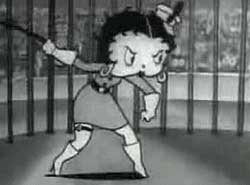 Betty's a circus headliner in Boop-oop-a-doop (1932), a setting that provides for many colorful gags. The opening title credit has Arthur Jarrett (probably) singing Betty's first theme song, which begins "There's a little queen/ Of the silver screen/ Wait 'til you/ Get to view/ Sweet Betty."
Betty's a circus headliner in Boop-oop-a-doop (1932), a setting that provides for many colorful gags. The opening title credit has Arthur Jarrett (probably) singing Betty's first theme song, which begins "There's a little queen/ Of the silver screen/ Wait 'til you/ Get to view/ Sweet Betty."
Koko is the circus's clown, making his appearance in the circus parade when an elephant (with a rubber tire patch on his side) reaches his trunk into the inkpot on his back, then squirts ink on the ground which leaps up as Koko.
After a glimpse of Betty on horseback we're treated to numerous acts & don't see her for a while. A hippopotamus leaps from a high platform into a pool of water. A lion swings on a trapeze by his teeth, but falls because they're false teeth. Although the gags aren't always effective, the animation design is wonderful, with strange little touches here & there, like the ringmaster's mustache the tips of which form very active hands as he makes his announcement.
A recurring gag has Bimbo, who sells peanuts in the bigtop, getting in front of the infant Aloysius blocking his view while trying to sell peanuts. When the baby finally breaks down & wants to buy some peanuts, Bimbo doesn't have any.
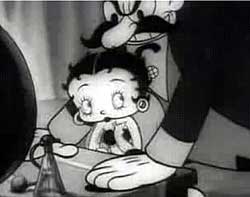 When Betty's back, she's a lion tamer, very bold imagery. One of the lions is sneaking up behind her & she doesn't seem to notice, but he just wants to pick up her handkerchief for her. She next turns up as a highwire walker, in a revealing two-piece outfit. When Betty's back, she's a lion tamer, very bold imagery. One of the lions is sneaking up behind her & she doesn't seem to notice, but he just wants to pick up her handkerchief for her. She next turns up as a highwire walker, in a revealing two-piece outfit.
Upon the highwire, Betty sings a jazz number, "Do Something, Boop-oop-a-doop," which had been a hit song for Helen Kane in 1929; Betty, of course, was based on flapper ragtime singer Helen Kane.
The fat ringmaster becomes a horrible masher who lurks by Betty's tent & waits for her to return between acts. He's pure evil, feeling her up & down, threatening her job, & when she won't give into him decides he's going to strangle her until her voice is gone.
She escapes his clutches to sing, "You can feed me bread & water/ Or a great big bail of Hay/ Oh, but don't take my boop-oop-a-doop away."
Koko comes to save Betty, & even after the fat villain gets the better of Koko & stuffs him in a canon, Koko manages to take the bastard down. It's a pretty cool 'toon with a cool tune.
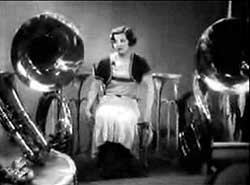 That song "Don't Take My Boop-oop-a-doop Away" was sung the year before by Mae Questal (the voice of Betty Boop) in the short film Musical Justice (1931), a rare chance to see Mae not animated; her character's name is Betty Boop. For crimes against popular music, the judge is empowered to take away Betty's Boop-oop-a-doop, which sets her to singing the aforementioned number.
That song "Don't Take My Boop-oop-a-doop Away" was sung the year before by Mae Questal (the voice of Betty Boop) in the short film Musical Justice (1931), a rare chance to see Mae not animated; her character's name is Betty Boop. For crimes against popular music, the judge is empowered to take away Betty's Boop-oop-a-doop, which sets her to singing the aforementioned number.
The song was written by Samuel Lerner, with lyrics by Sammy Timberg; they also wrote "I'm Popeye the Sailor Man," as well as another Betty Boop classic "Keep a Little Song Handy."
The star of Musical Justice is Rudy Vallee, the judge presiding over the Court of Musical Justice, together with a jury made up of his back-up group the Connecticut Yankees. The judge must decide the guilt or innocence of good taste for Betty Boop, who sits in a courtroom dock that is just a regular chair between two tubas.
Rudy sings his hit song "A Little Kiss Each Morning" written by Harry M. Woods, plus "I'm On the Jury Now" by Lerner & Timberg.
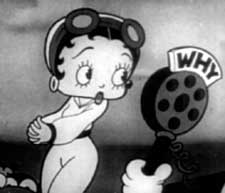 Classic Betty Boop is a race car driver in Ker Choo (1933). Koko the Clown & Bimbo the Dog are among the rival racers. She shows up with a cold &am sings "I Got a Tode in My Nose" in the style of flapper jazz. Classic Betty Boop is a race car driver in Ker Choo (1933). Koko the Clown & Bimbo the Dog are among the rival racers. She shows up with a cold &am sings "I Got a Tode in My Nose" in the style of flapper jazz.
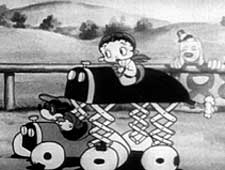 The starting pistol goes off, periodocially in the lead. The gags are all pretty standard, nothing outstanding. The starting pistol goes off, periodocially in the lead. The gags are all pretty standard, nothing outstanding.
The exception is the minor oddity of Betty's car being a Jew. The car can talk, & does so with a Yiddish accent (there is evidence in several of her films that Betty, like the Fleischer brothers, was herself a Jew). In the chaos of the climax, Betty wins the race -- by a sneeze.
It's not much of a story for Betty, but she's at least groundbreakingly an action heroine, & her musical performance is dandy. The jazzy novelty number was composed by Scott Bradley, who would continue write tunes for cartoons right on through the 1950s; with lyrics by Joseph Hanna
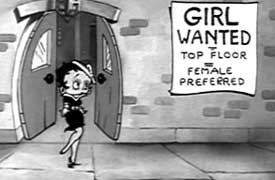 Betty tried a lot of careers in her day, some groundbreaking like race car driving or serving as president of the united states (in Betty Boop for President, 1932), other jobs rather retro, like nurse, babysitter, waitress, maid, or office temp.
Betty tried a lot of careers in her day, some groundbreaking like race car driving or serving as president of the united states (in Betty Boop for President, 1932), other jobs rather retro, like nurse, babysitter, waitress, maid, or office temp.
Some of the lesser jobs we may suppose were from necessity while pursuing her real career as a burlesque dancer & vaudeville jazz singer.
It'll be one of her more retro jobs in Betty Boop's Big Boss (1933). A ragtime crooner is singing over the opening titles: "Betty, you knock me for a loop de loop" including lyrics about getting married, which she never did.
Betty applies for a job on the top floor of an office tower. Jobs are in short supply in these Depression times & a hundred others show up at the same time.
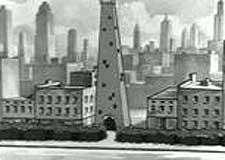 The boss asks what she's good at, & she sings a daring little lyric from Irving Berlin: "When you get me alone, you'd be surprised." That's all he needs to know; Betty gets the job, sending all the ugly gals down a trapdoor. The boss asks what she's good at, & she sings a daring little lyric from Irving Berlin: "When you get me alone, you'd be surprised." That's all he needs to know; Betty gets the job, sending all the ugly gals down a trapdoor.
The boss moons over his singing & dancing secretary. Turns out she can't type well, but she's a great decoration for the office, which must've insulted women who did this sort of work even in 1933.
Since she calls him "woopsy-poopsy" & flirts about her own incompetence, it's not too surprising that he chases her round & round the office like a slavering rapist, & even the sentient door colludes to lock her in.
The threat of rape is rather too obviously so Betty gets on a phone & calls the cops. Hundreds of cops (doggies & piggies) are on their way by foot parade, by police car, by aeroplane, by ships of sea, & end up in a shoot-out with the crazy boss, firing at each other point-blank without injury.
Betty exclaims "I want to play too!" & loads the pencil sharpener with pencils to use it as a machinegun. By the time Betty is just about rescued, she makes it clear she likes being pawed & molested, & the cops exclaim, "How do you like that."
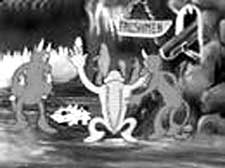 Red Hot Mama (1934) may well be the last Betty Boop cartoon produced without consideration for the severe restrictions of the Production Code of 1934, & thus marks the end of the "Betty Boop Classique" era. Red Hot Mama (1934) may well be the last Betty Boop cartoon produced without consideration for the severe restrictions of the Production Code of 1934, & thus marks the end of the "Betty Boop Classique" era.
She would after this be Grampy's granddaughter, Junior's babysitter, & Pudgy the Puppy's owner, & decreasingly associated with vaudeville, jazz, & sensuality.
One snowy night, Betty jumps out of bed to shut the windows in her see-through nighty. She stars a fire in the fireplace & makes a little bed on the floor in front of the fire to go back to sleep, while two chickens roost so close to the flames they turn into roasted birds.
The temperature in the room rises & rises. Candles melt. The thermometer explodes. An igloo in a hanging picture of eskimos melts.
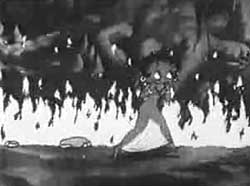 The fireplace turns into a flame-encircled doorway. Betty gets up & goes into a cavern, chased by a baby flame she shoos & tells to go home. She's still in her lovely long nighty which becomes transluscent every time she passes a fire. The fireplace turns into a flame-encircled doorway. Betty gets up & goes into a cavern, chased by a baby flame she shoos & tells to go home. She's still in her lovely long nighty which becomes transluscent every time she passes a fire.
Hell's Bells are ringing above her head just before she falls into a pit, landing on a toadstool. Demons are at work transforming newly arriving souls into horned devils with tails. The novice demons are gathering inside a weird helmet-shaped house. Firemen-devils come in their fire engine arrive to spray the odd building with fire.
Betty sings "Hell's Bells (It's Certainly Hot)," a fine piece of swing jazz written by bandleader Art Kassel in 1932, a hit for Art Kassel & His Kassels-in-the-Air.
As Betty dances amidst the flames, a choras line of demons joins the dance. A big demon with a king's crown tongues an icecream cone made of fire. He then turns up the flames.
"Wow am I hot!" says Betty, & the demons agree. The fire-breahting demon-king & his minions are yelling "Hey baby!" as they close in on her. But Betty stares daggers of ice at all of them, & Hell freezes over!
Betty falls through a crack in the ice & she wakes up in front of the fireplace, the fire having gone out. She runs back to her bed & covers herself with lots of blankets, with a "boop oop a doop!" for goodbye.
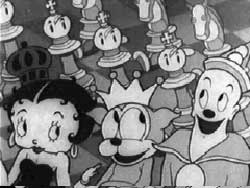 Opening with live-action film of two chess players, the black queen turns into Betty Boop, the king turns into Old King Cole, & a white king is Bimbo. Suddenly we're in the cartoon Chess Nuts (1932).
Opening with live-action film of two chess players, the black queen turns into Betty Boop, the king turns into Old King Cole, & a white king is Bimbo. Suddenly we're in the cartoon Chess Nuts (1932).
Soon there are cartoon characters, including Koko the Clown, rushing all over the checkered floor having a battle. Betty sings a silly song & other incidental songs are sung including "And Bimbo is his Name" to the tune of the song about Bingo the dog.
Betty becomes a damsel in distress in one of the castles, rather than the powerful queen of an actual chess board, with Bimbo on the way as savior. After some troubles here & there, Bimbo wins & that's that.
Although not one of the better Boops, it does incorporate some daringly naughty moments. When the King first gets Betty in a rope for the bondage scenes that follow, lest anyone think a little B&D wasn't the conscious intent, her dress is almost entirely stripped off, & the King's lustfulness is broadly drawn.
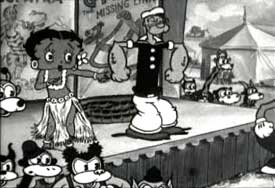 Betty only once appeared in a Fleischer Brothers cartoon alongside Popeye, & it was for Popey's debut film, Popeye the Sailor (1933). The full title was intended to be Popeye the Sailor with Betty Boop but "with Betty Boop" appears on a separate title card & only on the working script as the full actual title.
Betty only once appeared in a Fleischer Brothers cartoon alongside Popeye, & it was for Popey's debut film, Popeye the Sailor (1933). The full title was intended to be Popeye the Sailor with Betty Boop but "with Betty Boop" appears on a separate title card & only on the working script as the full actual title.
It was presumed that Betty's established popularity would help sell Popeye. How ironic that his popularity would eventually eclipse Betty's, with his cartoon adventures produced well after hers had ceased.
She sings the final verse of the Popey themesong behind the opening title card, not the more famous theme but the one that begins "Strike up the band for Popeye the Sailor/ Cash in his hand right off a whaler."
The more famous theme is sung by Popeye himself in the first scene, which announces in the newspaper that the King Features sailor was going to be starring in a movie. As he sings, he performs some feats of strength like punching a ship's mast into wooden clothespins.
He's got shoreleave. He meets Olive Oyl on the docks, punching a few mashers including Bluto who had harrassed her as she waited for her man.
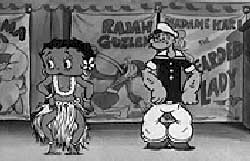 Olive & Popeye head off to the carnival for a date, with crude Bluto stalking them. There follow a number of gags in which Bluto proves how strong he is but Popeye follows up with much grander strength. Olive & Popeye head off to the carnival for a date, with crude Bluto stalking them. There follow a number of gags in which Bluto proves how strong he is but Popeye follows up with much grander strength.
For example, Bluto easily rings the bell with the enormous mallet, but Popeye crunches up the mallet into sawdust by rubbing it in the palms of his hands, then hits the gong by pounding the plank with his fist.
Betty Boop shows up as the hoochie-koochie dancer recycling & adding to the rotoscoped hoola dance from Bamboo Isle (1932) against a new backdrop of circus posters, & singing a new song.
Popeye leaps on the stage & dances with her. While Popeye's flirting with Betty, Olive Oyl gets kidnapped by Bluto who runs off into the hills with her. Betty warns Popey, "Oh, looky!"
That's it for Betty's cameo, as Popeye heads off to save Olive from the railroad tracks Bluto bound her too. Bluto stands in the way & they're fighting something awful as the train barrels down on Olive.
Popeye's not getting the worst of it at all, but he has to speed up the fight, so he downs a can of spinach, knocks out Bluto in a single punch & a tree that turns into his coffin, then stands in front of the train wrecking it to save Olive.
Mae Questal the famed voice of Betty Boop created another voice for Olive, & continued to do her voice for some while after Betty was discontinued.
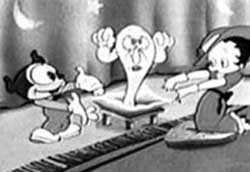 Professor Bimbo is operating a palm-reading joint in Is My Palm Read (1933). Koko the Clown is his doorman. It seems to be an awfully big company for mere fortune telling.
Professor Bimbo is operating a palm-reading joint in Is My Palm Read (1933). Koko the Clown is his doorman. It seems to be an awfully big company for mere fortune telling.
With a "hokus pokus bippity zippity" Bimbo the dog scries a crystal ball, revealing a storm-tossed journey in the crystal's depths, & Betty cast ashore on tropical island.
She sings an Irving Berlin tune which runs in part: "All by Myself in the Morning, All By Myself at Night." But she's not really alone as there are ghosts that imprison her in a straw hut.
Bimbo plays a second role as a sailor on horseback who turns up on the island without explanation. He saves Betty & flees from the island with her in his squirrel-powered skiff.
After seeing this in the crystal, Betty thinks Bimbo is her hero. He rips off his turban & beard to reveal he's her old boyfriend Bimbo from back in the days when she was part dog.
One of the ghosts pops out from under the crystal ball & cries "Bunko!" & rips off Betty's long dress to reveal her in skimpy hoola dress, as Betty's evidentally a conspirator in Bimpo's flimflam show. The bunko squad of ghosts doesn't make any sense, but otherwise, cool cartoon.
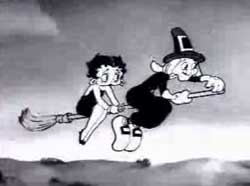 A rather silly ragtime song behind the opening credits promises such things as "You'll meet the Pied Piper, his mother too/ There's King Cole & his fiddlers, & Little Boy Blue," just as soon as when we get to Mother Goose Land (1933).
A rather silly ragtime song behind the opening credits promises such things as "You'll meet the Pied Piper, his mother too/ There's King Cole & his fiddlers, & Little Boy Blue," just as soon as when we get to Mother Goose Land (1933).
Betty's in bed in a long gown reading Mother Goose rhymes to herself, the moon outside her bedroom window. There's a lovely little foot-fetish moment for "This Little Piggy" so if you know any guys that swing that way, a copy of this cartoon is their next Christmas present.
Betty sings about how she'd love to go on a journey with Mother Goose, meeting all the familiar characters of her nation. As she makes these wishes known, Mother Goose jumps off the cover of Betty's book, grows to full size, & takes Betty away on her witch's broom, with an unseen choras singing "Sleeping The Clouds Away" & other rhymes.
At Mother Goose Land, Betty gets a huge greeting from all the well known Mother Goose characters, & she sings a Hello song to everyone. Nearly all the dialogue that occurs is sung, but no attempt has been made to make the tunes actually appealing.
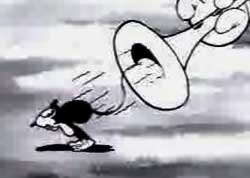 Rather than a story involving characters from Mother Goose rhymes, we get a gallery of minor gags set to music only because it was easier in the 1930s to match music to animated mouth movements than it was for the spoken word. Rather than a story involving characters from Mother Goose rhymes, we get a gallery of minor gags set to music only because it was easier in the 1930s to match music to animated mouth movements than it was for the spoken word.
Nine times out of ten this tendency to trivial music would be true of all early sound cartoons & better's not expected. Only the fact that Betty's cartoons so often featured first-rate jazz in this period makes it disappointing rather than expected.
For me the best gag was the last rat that refused to drown itself to the Pied Piper's tune (& never mind that he's not a Mother Goose character). The rat pulls out his harmonica & with his tune forces the Piper to dance, & eventually drown himself. Ratz rool.
The spider that frightened away Miss Muffet chases Betty. When Humpty Dumpty has a great fall, dozens of birds hatch out of him. The spider is still right behind Betty who rushes by the Old Lady & all her kids who lived in the shoe. The shoe laces the family inside for safety, then runs off toward the horizon.
Four & twenty blackbirds leap out of Old King Cole's pie to harrass the spider for harrassing Betty, while the choras sings "Bye Bye Blackbird." It ends with everyone playing ring around the rosies & Mother Goose's false teeth falling out.
One expects something sexier from the pre-Code episodes, but this one's highly imaginative for kids.
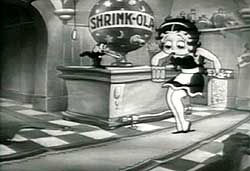 The Mother Goose journey is kind of a partner for the so-so Betty Boop in Blunderland (1934), not one of the great Boops, but fun. The Mother Goose journey is kind of a partner for the so-so Betty Boop in Blunderland (1934), not one of the great Boops, but fun.
Betty is putting together a jigsaw puzzle of a scene in Alice in Wonderland. She falls asleep & the jigsaw piece of the rabbit comes alive & climbs through the mirror. Betty apparently wakes up & follows through the mirror.
In Blunderland her hair is really long & her flapper dress becomes flouncy. She falls down the subway rabbit hole, finds Ed Wynn's head in a jar of jam, crawls through a tunnel, still after the bunny.
She gets some Shrink-Cola from the soda bar so that she can enter into Blunderland proper, where she meets the Mad Hatter, the Dutchess, Humpty Dumpty, & all the other characters, to whom she sings "How Do You Do."
Plenty of standard cartoon gags follow, except with Lewis Carol characters. The Jabberwocky captures Betty & other characters have to save her, including a speedy mock turtle who turns into an army tank. When all seems lost Betty wakes up by her puzzle.
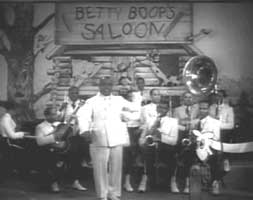 The live-action prelude for I Heard (1933) shows Don Redman & His Orchestra on a set with the background painted as Betty Boop's Saloon, including some simple puppet action of animal characters at the saloon window. The live-action prelude for I Heard (1933) shows Don Redman & His Orchestra on a set with the background painted as Betty Boop's Saloon, including some simple puppet action of animal characters at the saloon window.
Don Redman (1900-1964) was one of the true pioneer jazz men for the big-band swing sound. He worked with Louis Armstrong, Fletcher Henderson, Paul Whiteman, Count Basie, Jimmy Dorsey, & he directed the Pearl Bailey Band.
He recorded "Doing the New Lowdown" with Cab Calloway & the Mills Brothers. The Betty Boop cartoon is a rare opportunity to see him early on, performing with his own band.
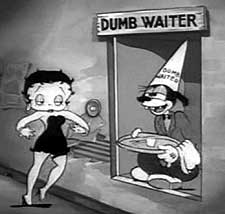 The cartoon opens with a scene of modern mining. The lunch whistle blows & among those who come up from the mines & hurry into Betty's bar & dinner are Koko the Clown & Bimbo the Dog. The cartoon opens with a scene of modern mining. The lunch whistle blows & among those who come up from the mines & hurry into Betty's bar & dinner are Koko the Clown & Bimbo the Dog.
A waiter dog sings, "I know a gal named Betty Boop, Oh how she can Boop-boop Oopy Doop. She likes to dance. She likes to sing. Oh, she'll take a chance on most any old thing."
Then Betty comes out & sings, "How'm I doing? Tweet tweet tweet twat twah" while there are miner customer & restaurant worker gags going on.
The music is just great. The cigar-smoking whistle blows for lunch hour's end & everyone heads off back into the mines. Bimbo goes around underground telling people "I heard. I heard. I heard," but doesn't quite get round to revealing what he heard.
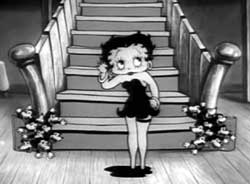 The rumor spreads musically here & there. Betty hears the rumor & gets in the restaurant's dumbwaiter to ride down in the mines, losing her dress in the crash so we get to see her in her undies. The wonderful song "I Heard" was co-written by Don Redman & Irvine Mills. The rumor spreads musically here & there. Betty hears the rumor & gets in the restaurant's dumbwaiter to ride down in the mines, losing her dress in the crash so we get to see her in her undies. The wonderful song "I Heard" was co-written by Don Redman & Irvine Mills.
Turns out there are ghosts down in the mines & they've built a bomb. Betty & Bimbo escape in the nick of time before the bomb goes off, but apparently everyone else dies, because that's what miners did in those days, & even now.
I presume it's Harlan Lattimore singing for Bimbo & for the waiter in Betty's Saloon. Harlan was known as "the black Bing Crosby" for his smooth style, but his career ended in 1936 when Redman could no longer put up with his unreliability, & no one else would ever take a chance with him.
In his own band, Harlan Lattimore & his Connies Inn Band, he had a hit song in 1932, "Reefer Man," which Cab Calloway also recorded. Reefer couldn't've been the worst of Harlan's recreational habits or his career might not have ended up in the dumpster.
copyright © by Paghat the Ratgirl
|
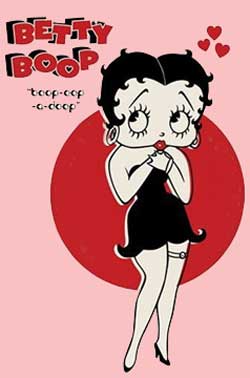

 When Betty's back, she's a lion tamer, very bold imagery. One of the lions is sneaking up behind her & she doesn't seem to notice, but he just wants to pick up her handkerchief for her. She next turns up as a highwire walker, in a revealing two-piece outfit.
When Betty's back, she's a lion tamer, very bold imagery. One of the lions is sneaking up behind her & she doesn't seem to notice, but he just wants to pick up her handkerchief for her. She next turns up as a highwire walker, in a revealing two-piece outfit.

 The starting pistol goes off, periodocially in the lead. The gags are all pretty standard, nothing outstanding.
The starting pistol goes off, periodocially in the lead. The gags are all pretty standard, nothing outstanding.
 The boss asks what she's good at, & she sings a daring little lyric from Irving Berlin: "When you get me alone, you'd be surprised." That's all he needs to know; Betty gets the job, sending all the ugly gals down a trapdoor.
The boss asks what she's good at, & she sings a daring little lyric from Irving Berlin: "When you get me alone, you'd be surprised." That's all he needs to know; Betty gets the job, sending all the ugly gals down a trapdoor.
 The fireplace turns into a flame-encircled doorway. Betty gets up & goes into a cavern, chased by a baby flame she shoos & tells to go home. She's still in her lovely long nighty which becomes transluscent every time she passes a fire.
The fireplace turns into a flame-encircled doorway. Betty gets up & goes into a cavern, chased by a baby flame she shoos & tells to go home. She's still in her lovely long nighty which becomes transluscent every time she passes a fire.

 Olive & Popeye head off to the carnival for a date, with crude Bluto stalking them. There follow a number of gags in which Bluto proves how strong he is but Popeye follows up with much grander strength.
Olive & Popeye head off to the carnival for a date, with crude Bluto stalking them. There follow a number of gags in which Bluto proves how strong he is but Popeye follows up with much grander strength.

 Rather than a story involving characters from Mother Goose rhymes, we get a gallery of minor gags set to music only because it was easier in the 1930s to match music to animated mouth movements than it was for the spoken word.
Rather than a story involving characters from Mother Goose rhymes, we get a gallery of minor gags set to music only because it was easier in the 1930s to match music to animated mouth movements than it was for the spoken word.

 The cartoon opens with a scene of modern mining. The lunch whistle blows & among those who come up from the mines & hurry into Betty's bar & dinner are Koko the Clown & Bimbo the Dog.
The cartoon opens with a scene of modern mining. The lunch whistle blows & among those who come up from the mines & hurry into Betty's bar & dinner are Koko the Clown & Bimbo the Dog. The rumor spreads musically here & there. Betty hears the rumor & gets in the restaurant's dumbwaiter to ride down in the mines, losing her dress in the crash so we get to see her in her undies. The wonderful song "I Heard" was co-written by Don Redman & Irvine Mills.
The rumor spreads musically here & there. Betty hears the rumor & gets in the restaurant's dumbwaiter to ride down in the mines, losing her dress in the crash so we get to see her in her undies. The wonderful song "I Heard" was co-written by Don Redman & Irvine Mills.